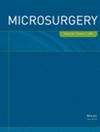Analysis of flap thickness to breast projection ratio correlating to body mass index and age in east Asian women: Considerations in flap selection in breast reconstruction
Abstract
Background
Several alternative flaps have been introduced and used for autologous breast reconstruction. However, as body fat distribution is different among patients, the donor of choice for sufficient breast projection varies between patients.
Methods
Patients who underwent autologous breast reconstruction from Jan 2018 to Sep 2022 were included. Age, body mass index (BMI), smoking history and hypertension, and diabetes occurrence were collected as baseline demographic data. Breast projection with five types of flap thickness was measured based on computed tomography angiography. Analysis was performed for five major autologous flaps for breast reconstruction.
Results
A total of 563 patients were included in the study. The mean age of the patients was 47.4 ± 7.9 (standard deviation; SD) years. The mean BMI of the patients was 24.0 ± 3.4 kg/m2. Only the correlation between flap thickness to breast projection ratio and age in the PAP flap illustrated statistical significance (p = .039), but the correlation coefficient was quite low (r = −0.087). Slim patients who had lower BMIs (under 25 kg/m2) had significantly higher sufficient flap thickness for breast reconstruction than patients with higher BMIs over 25 kg/m2 in the profunda artery perforator (PAP) flap (p < .001), the lumbar artery perforator (LAP) flap (p < .001), and the superior gluteal artery perforator (SGAP) flap (p < .001).
Conclusions
The deep inferior epigastric perforator flap provided sufficient thickness and was not usually affected by age and BMI. The PAP, LAP, and SGAP flaps tended to maintain the thickness of the flap even when BMI decreased, so they are advantageous for reconstruction in slim patients. This study contributes evidence in consideration of flap selection in autologous breast reconstruction.

 求助内容:
求助内容: 应助结果提醒方式:
应助结果提醒方式:


